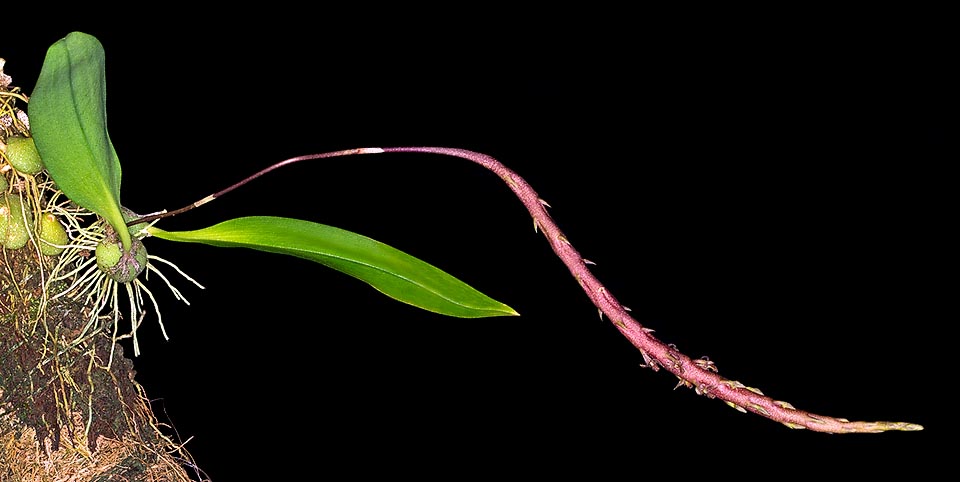Family : Orchidaceae

Text © Pietro Puccio

English translation by Mario Beltramini

Small epiphyte of Philippines and Sulawesi humid forests, Bulbophyllum echinochilum has subglobose pseudobulbs, depressed, less than 2 cm, with a unique 8-10 cm leaf. The inflorescence, coming at the base of the pseudobulb, reaches 20 cm, with 8 cm fusiform rachis, purple dotted of white, and tiny spaced flowers © Giuseppe Mazza
The species is native to Philippines (Luzon) and Sulawesi where it grows in the humid forests around the 1000 m of altitude.
The name of the genus is the combination of the Greek substantives “βολβός” (bolbos) = bulb and “φύλλον” (phyllon) = leaf, with reference to the leaves growing at the apex of the pseudobulbs; the specific name is the combination of the Greek substantives “ἐχῖνος” = hedgehog, porcupine, and “χεῖλος” (cheilos) = lip, with reference to the labellum densely covered by hairs.
The Bulbophyllum echinochilum Kraenzl. (1921) is an epiphytic species with subglobose pseudobulbs, depressed, 1,2-1,5 cm tall and of 1,6-2 cm of diameter, arranged one after the other on a creeping rhizome rooting at the nodes and provided of only one oblong-elliptic leave with pointed apex, 8-10 cm long and 1,5-2 cm broad, coriaceous.

Very characteristic flowers. Retroflexed, about 6 mm long, triangular sepals, with pointed apex, whitish urbicular petals with ciliate brown-reddish margins, 1 mm long and broad, fleshy linear labellum, 3-4 mm long, purple, grooved above, at the centre, and covered below by thick 1-2 mm hairs © Giuseppe Mazza
<doc23484|center>It reproduces by seed, in vitro, and by division, with each section provided of at least 3-4 pseudobulbs, at the vegetative restart.
Miniature orchid with the characteristic flowers, requires a semi-shady position, medium-high temperatures, 22-30 °C, high humidity, 70-85%, and air in constant movement. The plant is to be regularly watered, but allowing the substratum to slightly dry up between the waterings, utilizing rain water, demineralized or by reverse osmosis. Monthly fertilizations, during the growth period, with a hydrosoluble balanced product, with microelements, at ¼ the dosage shown on the package. It can be mounted on trunks, bark, rafts of cork or of arborescent ferns roots, or cultivated in pots or baskets with a compost that may be formed by medium-sliced bark fragments with possible addition of inerts to improve the drainage. The repottings are to be done at the vegetative restart when the compost presents signs of deterioration.
The species is reported in the appendix II of CITES (species whose trade is internationally ruled).
→ For general notions about ORCHIDACEAE please click here.
